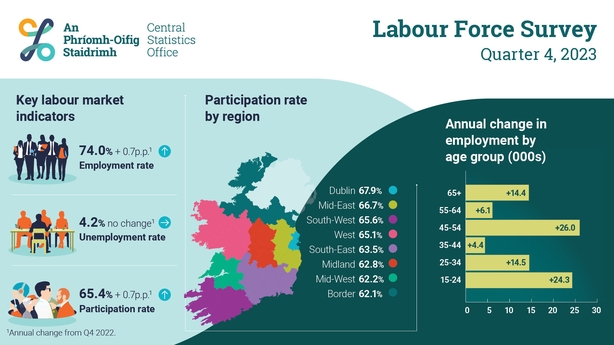New figures from the Central Statistics Office show that the estimated number of people in employment in the fourth quarter of 2023 stood at 2,706,400, up 3.4% compared with the same time in 2022.
The 3.4% increase was equivalent to 89,600 more people working than 12 months earlier.
The CSO's latest Labour Force survey showed that the employment rate for people between the ages of 15 to 64 was 74% in the last three months of the year.
It noted that the age group with the highest employment rate was the 35-44 year-old group, which was unchanged from a year previously at 84%, while the lowest employment rate by age was seen in the 15-19 year old cohort at 28.1%.
Today's CSO figures show that all other age groupings saw an increase in employment rate with the exception of 55-59 year olds, where there was a slight decline to 72.3%.
They also show that the estimated Labour Force - which includes everyone from the age of 15 to 89 years who were either employed or unemployed - stood at 2,824,100 in the fourth quarter of last year, up by 3.5% from 2022.
The estimated participation rate rose to 65.4% from 64.6% during the same time in 2022.

Meanwhile, the estimated total number of hours worked per week during October, November and December last year increased by 300,000 hours or 0.4% to 82.5 million hours.
The sectors that saw the largest year-on-year employment growth in the last three months of the year were the Education sector, which increased employment by 12.2%, while the Agriculture, Forestry & Fishing sector grew by 9%.
On unemployment, the CSO said the number of people aged 15-74 years who were without a job in the fourth quarter of 2023 stood at 117,700, with an associated jobless rate of 4.2%.
The youth unemployment rate rose to 9.4% during the three months under review from a rate of 9.1% a year earlier.
Today's CSO figures show that there were 29,500 people in long-term unemployment - unemployed for 12 months or longer - during the last three months of 2023 - a decrease of 4,900 people from Q4 2022.
The corresponding rate of long-term unemployment was 1.1%, down from 1.3% a year earlier, it added.
The CSO's most recent unemployment figures - published last month - showed that the jobless rate stood at 4.5% in both December and January after the December rate was revised down from 4.9%.
The Minister for Enterprise, Trade and Employment Simon Coveney said that 2023 was an exceptional year for the Irish labour market, which finished strong in the final quarter with 2.7 million people employed in our country, another historic high.

The Minister said it was encouraging to see record numbers of women availing of opportunities for employment, with female participation rates in the labour market trending upwards in recent years.
"It is also promising that the geographic pattern of employment growth has been so positive, which is a testament to this Government's commitment to achieving more balanced regional enterprise development," he added.
The Minister for Finance Michael McGrath TD said that almost three-quarters of the country's working age population are now in employment.
"Continuing the trend seen in recent quarters, the strong growth in employment in the fourth quarter was driven by additions to labour supply, by net inward migration and as well as increased participation," he added.
The Minister also noted that today's figures point to some easing of the tight conditions that have characterised the labour market over the past year.
"While the unemployment rate - at 4.5% - remains low by historical standards, the increase in the rate in the second half of 2023 is in keeping with a general softening in economic conditions, with external conditions particularly challenging in the face of many headwinds," Mr McGrath said.
"With labour demand having eased in recent months and labour supply remaining robust, the labour market now appears to be returning to a more balanced position, a welcome development that should help alleviate some of the concerns relating to overheating pressures," he added.

